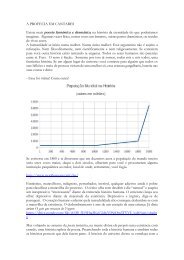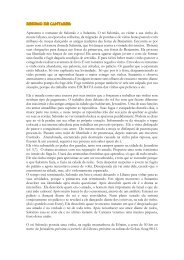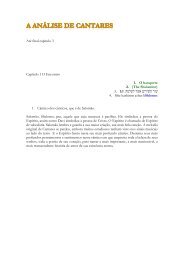Motherhood in Childhood
You also want an ePaper? Increase the reach of your titles
YUMPU automatically turns print PDFs into web optimized ePapers that Google loves.
Monitor<strong>in</strong>g ICPD Goals – Selected Indicators<br />
Indicators of Mortality Indicators of Education Reproductive Health Indicators<br />
of childbear<strong>in</strong>g among adolescent Infant women Life expectancy 15 to 19 years Maternal of age. For Primary civil enrolment regional, Proportion and global Secondary rates and % trends Illiterate <strong>in</strong> contraceptive Births per Contraceptive prevalence and HIV<br />
registration, rates are subject mortality to limitations M/F which depend mortality on the completeness<br />
of birth registration, 1,000 the live treatment of <strong>in</strong>fants born alive but and comprehensive review’. The Lancet, 12 March aged 2013. Any World Modern and (15-49)<br />
(gross) M/F unmet reach<strong>in</strong>g need grade 5 for enrolment family plann<strong>in</strong>g (>15 between1990 years) 1,000 and 2015: Prevalence a systematic prevalence<br />
Total per<br />
ratio<br />
M/F<br />
(gross) M/F M/F<br />
women<br />
rate (%)<br />
births<br />
15-19<br />
method methods<br />
M/F<br />
dead before registration or with<strong>in</strong> the first 24 hours of life, the quality of regional data are based on United Nations Population Division/DESA<br />
the reported <strong>in</strong>formation relat<strong>in</strong>g to age of the mother, and the <strong>in</strong>clusion<br />
of births from previous periods. The population estimates may suffer<br />
from limitations connected to age misreport<strong>in</strong>g and coverage. For survey<br />
and census data, both the numerator and denom<strong>in</strong>ator come from the<br />
special analyses of data from United Nations, Department of Economic<br />
and Social Affairs, Population Division. World Contraceptive Use 2012<br />
and 2013 updates for the MDG database (see http://www.un.org/en/<br />
development/desa/population/).<br />
same population. The ma<strong>in</strong> limitations concern age misreport<strong>in</strong>g, birth<br />
omissions, misreport<strong>in</strong>g the date of birth of the child, and sampl<strong>in</strong>g<br />
variability <strong>in</strong> the case of surveys.<br />
Education<br />
Male and female net enrolment rate <strong>in</strong> primary education (adjusted),<br />
male and female net enrolment rate <strong>in</strong> secondary education, 1999-<br />
2012. Source: UNESCO Institute for Statistics, data release of May 2012.<br />
Under age 5 mortality, per 1,000 live births. Source: United Nations,<br />
Department of Economic and Social Affairs, Population Division (2011). World<br />
Population Prospects: The 2010 Revision. DVD Edition - Extended Dataset <strong>in</strong><br />
Excel and ASCII formats (United Nations publication, ST/ESA/SER.A/306).<br />
Under age 5 mortality is the probability (expressed as a rate per 1,000<br />
live births) of a child born <strong>in</strong> a specified year dy<strong>in</strong>g before reach<strong>in</strong>g the<br />
Accessible through: stats.uis.unesco.org. The net enrolment rates <strong>in</strong>dicate<br />
the enrolment of the official age group for a given level of education<br />
expressed as a percentage of the correspond<strong>in</strong>g population. The adjusted<br />
net enrolment rate <strong>in</strong> primary also <strong>in</strong>cludes children of official primary<br />
school age enrolled <strong>in</strong> secondary education. Data are for the most recent<br />
year estimates available for the 1999-2012 period.<br />
age of five if subject to current age-specific mortality rates.<br />
Sexual and reproductive health<br />
Contraceptive prevalence. United Nations, Department of Economic<br />
and Social Affairs, Population Division (2013). 2013 Update for the MDG<br />
Database: Contraceptive Prevalence (POP/DB/CP/A/MDG2012). These<br />
data are derived from sample survey reports and estimate the proportion<br />
of married women (<strong>in</strong>clud<strong>in</strong>g women <strong>in</strong> consensual unions) currently<br />
us<strong>in</strong>g, respectively, any method or modern methods of contraception.<br />
Modern or cl<strong>in</strong>ic and supply methods <strong>in</strong>clude male and female sterilization,<br />
IUD, the pill, <strong>in</strong>jectables, hormonal implants, condoms and<br />
female barrier methods. These numbers are roughly but not completely<br />
comparable across countries due to variation <strong>in</strong> the tim<strong>in</strong>g of the surveys<br />
and <strong>in</strong> the details of the questions. All country and regional data<br />
refer to women aged 15-49. The most recent survey data available are<br />
cited, rang<strong>in</strong>g from 1990-2011. World and regional data are based on<br />
United Nations Population Division/DESA special analyses of data from<br />
United Nations, Department of Economic and Social Affairs, Population<br />
Division. World Contraceptive Use 2012 and 2013 updates for the MDG<br />
database (see http://www.un.org/en/development/desa/population/).<br />
Unmet need for family plann<strong>in</strong>g. Source: United Nations, Department<br />
of Economic and Social Affairs, Population Division (2013). 2013<br />
Update for the MDG Database: Unmet Need for Family Plann<strong>in</strong>g (POP/<br />
DB/CP/B/MDG2012). Women with unmet need for spac<strong>in</strong>g births are<br />
those who are fecund and sexually active but are not us<strong>in</strong>g any method<br />
of contraception, and report want<strong>in</strong>g to delay the next child. This is<br />
a subcategory of total unmet need for family plann<strong>in</strong>g, which also<br />
<strong>in</strong>cludes unmet need for limit<strong>in</strong>g births. The concept of unmet need<br />
po<strong>in</strong>ts to the gap between women's reproductive <strong>in</strong>tentions and their<br />
contraceptive behavior. For MDG monitor<strong>in</strong>g, unmet need is expressed<br />
as a percentage based on women who are married or <strong>in</strong> a consensual<br />
union. The concept of unmet need for modern methods considers<br />
users of traditional methods as <strong>in</strong> need of modern contraception. For<br />
further analysis, see also Add<strong>in</strong>g It Up: Costs and Benefits of Contraceptive<br />
Services: Estimates for 2012. Guttmacher Institute and UNFPA, 2012<br />
and Alkema L., V. Kantorova, C. Menozzi, and A. Biddlecom “National,<br />
Demographic <strong>in</strong>dicators<br />
Total population, 2013. Source: United Nations, Department of<br />
Economic and Social Affairs, Population Division (2013). World<br />
Population Prospects: The 2012 Revision, CD-ROM Edition. These <strong>in</strong>dicators<br />
present the estimated size of national populations at mid-year.<br />
Average annual rate of population change, per cent. Source: United<br />
Nations, Department of Economic and Social Affairs, Population Division<br />
(2013). World Population Prospects: The 2012 Revision, CD-ROM Edition.<br />
Average annual rate of population change is the average exponential<br />
rate of growth of the population over a given period. It is based on a<br />
medium variant projection.<br />
Male and female life expectancy at birth. Source: United Nations,<br />
Department of Economic and Social Affairs, Population Division (2013).<br />
World Population Prospects: The 2012 Revision, CD-ROM Edition. These<br />
<strong>in</strong>dicators are measures of mortality levels, respectively, and represent<br />
the average number of years of life expected by a hypothetical cohort of<br />
<strong>in</strong>dividuals who would be subject dur<strong>in</strong>g all their lives to the mortality<br />
rates of a given period. Data are projections for the period 2010-2015<br />
and are expressed as years.<br />
Total fertility rate. Source: United Nations, Department of Economic<br />
and Social Affairs, Population Division (2013). World Population<br />
Prospects: The 2012 Revision, CD-ROM Edition. The measure <strong>in</strong>dicates<br />
the number of children a woman would have dur<strong>in</strong>g her reproductive<br />
years if she bore children at the rate estimated for different age groups<br />
<strong>in</strong> the specified time period. Countries may reach the projected level<br />
at different po<strong>in</strong>ts with<strong>in</strong> the period. Projections are for the period<br />
2010-2015.<br />
Population aged 10-19, per cent. Source: United Nations, Department<br />
of Economic and Social Affairs, Population Division (2013). World<br />
Population Prospects: The 2012 Revision, CD-ROM Edition. The measure<br />
<strong>in</strong>dicates the proportion of the population between the ages of 10<br />
and 19.<br />
110 110 INDICATORS INDICATORS

















